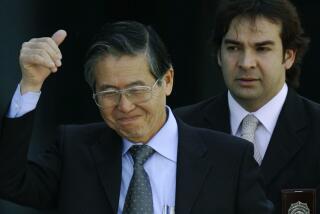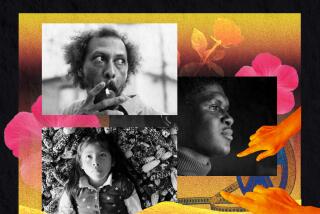In a Gray Light, Lima’s Softer Side Shines
LIMA, Peru — Poor Lima. It has no fine beaches, no spectacular Inca ruins. And except for the dead of the South American summer--January, February and March--when the Pacific Ocean fog burns off, it barely gets any sun.
Poor teeming Lima. Its urban sprawl of 8 million has grown 13-fold since 1960. If you read the description of Lima in the “Lonely Planet Guide to Peru,” as we did for the first time when already aboard our flight, you’ll want to ask the flight attendant for a parachute.
Lonely Planet pulls no punches in its description: Poor. Crowded. Gridlocked. Noisy. Dirty. Polluted. Flat. Gray. Boring. Nerve-racking. Welcome to Peru’s 467-year-old capital, a.k.a. “The City of Kings.” Oh, and, watch out for thieves and pickpockets. They’re everywhere.
OK, so Lima’s no day at Zuma Beach. It’s no wonder most travelers avoid it or fly in and out as quickly as possible to glorious Cuzco, the ancient two-mile-high gateway to the magnificent Incan ruins of Machu Picchu.
But as photographer Steven Adams and I discovered when we went in mid-October, Lima is an excellent place for Americans to encounter Peruvian culture, shop for bargains and experience the mad human rush of a first-class Third World city. And you can do all three without putting your life, health or credit card in any danger.
Lima sits on the Pacific coast in central Peru, but its easterly location--it is 3,586 miles almost directly south of Philadelphia--may surprise you. Its 39 city-sized political districts include the mostly middle-class communities of Surco and tourist-friendly Miraflores, whose tidy residential neighborhoods, up-market mini-malls and bustling business districts could impersonate parts of Miami or L.A.
Lima has its rough neighborhoods and dangerous shantytowns, to be sure. But few Americans would feel uncomfortable in Miraflores. It has nearly any luxury or cultural necessity the softest First Worlder could desire, from Tony Roma’s ribs and cell phone shops to ATMs and Internet cafes.
To be fair, Lonely Planet’s guide does note--though without much enthusiasm--that Lima has some of Peru’s most beautiful churches and best museums, including the “must-see” Mujica Gallo Gold Museum. And--somebody call Arthur Frommer!--it has fine dining and night life too. Of course, so does rusty old Pittsburgh, which is where Steve and I live and work for a daily newspaper.
We spent five days in Lima covering the travels of a globe-circling railroad entrepreneur from Pittsburgh named Henry Posner III. Posner’s management company operates small railroads in developing countries, including Peru’s Ferrocarril Central Andino railroad, the highest standard-gauge rail line in the world.
Twice a year the Ferrocarril, usually a freight line, hooks up with Trains Unlimited, Tours and runs a special over-the-Andes passenger excursion for British and U.S. railroad fans. Train enthusiasts pay upward of $5,000 to ride the rails in Peru and Ecuador for 18 days.
Before we took our weekend train ride, however, Steve and I had two full days to kill in Lima--or, as we joked after reading Lonely Planet’s warnings, “two days to be killed in Lima.”
When Posner visits Lima he stays in Miraflores at the Marriott or the Holiday Inn. We, however, did not cross the equator to pay the rates charged by those no-surprises chains. Before we left, Steve and I used www.peruhotel.com to reserve a room at the Hotel Antigua Miraflores, a former colonial mansion on a quiet side street in central Miraflores.
The price--$80 for a roomy double--included taxes and service charges and a generous continental breakfast (featuring ham-and-cheese omelets) in a lovely dining room. Hotel Antigua is loaded with character--ancient tile floors, chandeliers, balconies, gardens and lots of local art. The rooms have spiffy new bathrooms, pine colonial furniture and American cable TV channels. Manos Amigas, the gift shop, sells handmade wool sweaters and crafts by 25 local artisans at prices designed to pay the crafters fair wages. Fine men’s crewneck alpaca sweaters are as much as $50, more than double what you pay a few blocks away at places like the Miraflores Indian Market. There you’ll find guilt-inducing low prices: heavy woven wool jackets ($30), alpaca sweaters ($17) and scarves ($9).
Before we hit the sack on our first night in Miraflores, Steve and I checked out the local night life. At 1 a.m. the side streets were quiet, except for the parade of prowling taxis that honked as they passed. In the shadows of one street corner, a teenage soldier in camouflage stood guard with a submachine gun. After those warnings about thieves, he seemed more comforting than repressive.
Dozens of bars and restaurants were still open--and, like nearly every shop and eatery we entered during our stay, devoid of patrons.
The next morning there was no sun, no clouds, just a gray glow. The 60-degree air felt damp and chilly. Miraflores’ main drag, Avenida Jose Larco, was already crazy by 8:30, crammed with beeping taxis and maniacal minibuses. Shop owners swept their gritty sidewalks. Vendors were already hawking fruit, cookies and candies, and shoeshine boys like 14-year-old Walter were up early. With a primitive homemade shoeshine kit over his shoulder, he spotted us half a block away.
Walter, “the youngest of many brothers and sisters,” he says, wanted to re-whiten my white athletic shoes for only 5 soles, about $1.50. When I told him I like them dirty, Walter cut to the chase and asked for $10, “please, to eat.”
When he pitched me again 30 minutes later, I gave him $1 just to leave me alone. I appreciated his persistence. Besides, you never know: Alejandro Toledo, the new president of Peru, was once a shoeshine boy.
At the end of bustling Avenida Jose Larco, past the Marriott and down a steep cliff lurks the gray Pacific. Hardly a mile from our hotel, it laps quietly on a broad, empty beach, creating a beige froth of mysterious pollutants. It’s impossible to tell where the gray sea meets the gray sky.
With the palm trees, the high rises and the beach far below, it’s easy to imagine yourself in Santa Monica. Clinging to the cliff side is Larco Mar, a mall as upscale and as consumer friendly as any in L.A.
Two-tiered, patrolled by diligent private security guards, architecturally dolled up and lavishly landscaped with flowers and palm trees, its tenants include chocolate boutiques, high-priced alpaca sweater shops, cafes, a video arcade, a toy store, Hard Rock Cafe and Tony Roma’s. The mall was quiet at noon. But by evening Larco Mar’s terrazzo began to jump. Local kids came by the score to hang out, and couples of all ages came to clutch and smooch as Lima’s invisible sun set. The stiff evening onshore breeze kept several daredevils showing off in their parasails for an hour.
We ate lunch at the allegedly trendy Cafe Cafe near Parque Kennedy. Paying about $9 each for our mediocre tacos and icy Cusquena beers was no bargain compared with the dinner we had that night in Barranco, a bohemian suburb of artists and poets a 30-minute walk from Miraflores.
Our fresh sea bass, pie and coffee at Las Mesitas Restaurante Turistico cost us less than $11 each, including tip. It was simple but tasty fare, and the service was extra-diligent, mainly because there were only two other customers: a husband-wife team of alpaca importers from Michigan.
Friday morning we set out by cab for central Lima and one of the city’s biggest religious events: the 235th annual procession in honor of the Lord of the Miracles. The all-day Oct. 18 pageant honors a painting of Christ and the Virgin Mary that survived several earthquakes in the late 1600s. Attracting tens of thousands of worshipers and an army of street vendors, it features a huge double-sided religious image on a gold and silver platform so heavy it takes 54 straining men to carry it.
Lurching down broad avenues through thick crowds at about two blocks per hour, the procession--the flower-festooned platform, a peppy marching band and hundreds of purple-robed VIPs--was circled by a 3-inch-thick rope carried by police in burgundy berets.
We were exhausted by the time we stumbled into a tiny neighborhood restaurant where a pork and sweet potato sandwich on a roll and a soda cost about $2. At an amazingly busy street corner, where colorful minibuses arrived every 10 seconds, we hopped a tiny taxi to downtown Lima’s insane shopping district.
Our driver drove like every other cabby: He sped around like a madman, obeyed no traffic laws, never signaled, never gave another driver or pedestrian an inch, and beeped his horn constantly. Along the way, as if to remind us we were indeed in the developing world, we passed a man cooking a cow’s head in a small fire by an overpass.
In central Lima, the narrow pedestrian walkway between Plaza San Martin and Plaza de Armas is a wild outdoor shopping mall. A narrow canyon of storefronts and restaurants, it surged with thousands of shoppers and street vendors and money-changers and Indian flute players and police who twice warned Steve to guard his cameras.
For blocks in every direction, people were selling things. Most of Lima’s 300,000 street vendors, the core of the city’s so-called “informal sector,” seemed to be working Avenida Abancay. It seemed as though everyone was selling something: watchbands, batteries, magazines, slices of pineapple, flowers, cakes, toys, Toyota floor mats. Few seemed to be buying.
Except for the diesel fumes and the eternal threat of pickpockets, central Lima is civilized, safe and fascinating, a rich collision of colonial Spanish and Indian cultures with the best and worst of modern American commercialism.
Those who prefer their cities with tidy, traffic-free downtowns would be terrified by such a chaotic, energized and virtually unregulated sidewalk marketplace. But in poor Lima, where the people are friendly and invariably happy to find two norteamericanos in their madding midst, it is business and daily life as usual.
*
Guidebook: Learning About Lima
Getting there: From LAX, Lan Chile and Lan Peru offer nonstop service to Lima, and American, Northwest and Delta offer connecting service. Restricted round-trip fares begin at $496.
Telephones: To call the numbers below from the U.S., dial 011 (the international access code), 51 (country code for Peru), 1 (city code for Lima) and the local number.
Where to stay: Be sure to ask about taxes and service charges before booking. Also check www.peruhotel.com for information on other accommodations.
Hotel Antigua Miraflores, Avenida Grau 350, Miraflores, Lima; 241-6116, www.peru-hotels-inns.com. Rates for two from $79, including taxes, service charges and breakfast. Colonial character, friendly staff, quiet residential street, yet convenient to businesses and night life.
Holiday Inn Hotel & Suites, Miraflores, Avenida Benavides 300, Lima; 242-3200, fax 242-3193, www.holiday-inn.com. Rates for two, including breakfast, from $70 plus tax. Caters to international business travelers.
J.W. Marriott Hotel and Stellaris Casino, Malecon de la Reserva 615, Miraflores, Lima; 217-7000, fax 217-7100, www.marriott.com. Singles and doubles from $175 plus tax. Overlooking the Pacific Ocean, it has a casino and three restaurants on site.
Where to eat: We ate at Las Mesitas Restaurante Turistico in Barranco, 341 Avenida Grau, 477-4199; we both had sea bass, which was good. Entrees from $2.
We also grabbed a bite at Tony Roma’s, Avenida Malecon de la Reserva 610 in Miraflores, 242-9986, which is just like Tony Roma’s anywhere.
Breakfasts at the Hotel Antigua Miraflores (included in room rate) were good: coffee or tea and fresh orange juice, good hard rolls, plus excellent omelets and good service in an attractive eating area. Dinner about $17-$24.
For more information: Useful monthly English/Spanish Peru Guide is published by Lima Editora, Avenida Benavides 1180, Miraflores, Lima 18, Peru; 444-3849.
For other information, Consulate General of Peru, Tourist Information, 3450 Wilshire Blvd., Suite 800, Los Angeles, CA 90010; (213) 252-5910, fax (213) 252-8130.
*
William Steigerwald, formerly an editor at the Los Angeles Times, is a columnist and associate editor at the Pittsburgh Tribune-Review.
More to Read
Sign up for The Wild
We’ll help you find the best places to hike, bike and run, as well as the perfect silent spots for meditation and yoga.
You may occasionally receive promotional content from the Los Angeles Times.






